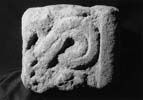Select a site alphabetically from the choices shown in the box below. Alternatively, browse sculptural examples using the Forward/Back buttons.
Chapters for this volume, along with copies of original in-text images, are available here.
Object type: Shaft fragment [1]
Measurements: L. 34 cm (13.4 in) W. 14 cm (5.5 in) D. 12 cm (4.8 in)
Stone type: Fine-grained micaceous deltaic sandstone with feldspar; sub-angular grains in a well sorted fabric. Yellowish brown (10YR 5/4). Certainly from the Saltwick Formation, Aalenian, Middle Jurassic; probably from the escarpment-top quarries to the south of the settlement in the Cleveland Hills
Plate numbers in printed volume: Ills. 296–8
Corpus volume reference: Vol 6 p. 118-119
(There may be more views or larger images available for this item. Click on the thumbnail image to view.)
This is a slice across a shaft, apparently for use as a building stone.
A (broad) : Within two flat band mouldings two interlaced knots survive. The strands are median incised with pecked outlines.
B (narrow) : Broken and covered with mortar.
C (broad) : Broken.
D (narrow) : A flat band moulding survives on the right enclosing a median-incised coil which could be a fragment of 'Como-braid' rather than knotted interlace or part of a ribbon animal.
There is very little that is diagnostic in this fragment, but if face D has a Como-braid pattern then it can be paralleled locally at Brompton, Kirklevington and Northallerton (Ills. 48, 401, 666), whilst the Leeds Church cross in the West Riding provides a very well cut parallel combined with Viking-age iconography (Collingwood 1915, 212–13).



